欧亨利短篇小说调查研究报告
- 格式:docx
- 大小:16.68 KB
- 文档页数:4
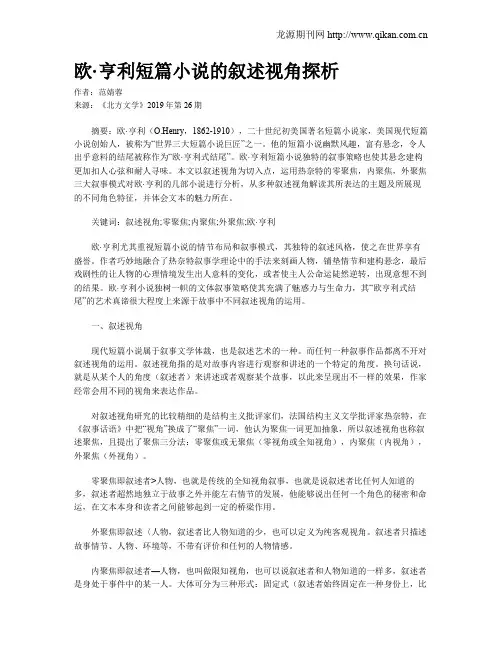
欧·亨利短篇小说的叙述视角探析作者:范婧蓉来源:《北方文学》2019年第26期摘要:欧·亨利(O.Henry,1862-1910),二十世纪初美国著名短篇小说家,美国现代短篇小说创始人,被称为“世界三大短篇小说巨匠”之一。
他的短篇小说幽默风趣,富有悬念,令人出乎意料的结尾被称作为“欧·亨利式结尾”。
欧·亨利短篇小说独特的叙事策略也使其悬念建构更加扣人心弦和耐人寻味。
本文以叙述视角为切入点,运用热奈特的零聚焦,内聚焦,外聚焦三大叙事模式对欧·亨利的几部小说进行分析,从多种叙述视角解读其所表达的主题及所展现的不同角色特征,并体会文本的魅力所在。
关键词:叙述视角;零聚焦;内聚焦;外聚焦;欧·亨利欧·亨利尤其重视短篇小说的情节布局和叙事模式,其独特的叙述风格,使之在世界享有盛誉。
作者巧妙地融合了热奈特叙事学理论中的手法来刻画人物,铺垫情节和建构悬念,最后戏剧性的让人物的心理情境发生出人意料的变化,或者使主人公命运陡然逆转,出现意想不到的结果。
欧·亨利小说独树一帜的文体叙事策略使其充满了魅惑力与生命力,其“欧亨利式结尾”的艺术真谛很大程度上来源于故事中不同叙述视角的运用。
一、叙述视角现代短篇小说属于叙事文学体裁,也是叙述艺术的一种。
而任何一种叙事作品都离不开对叙述视角的运用。
叙述视角指的是对故事内容进行观察和讲述的一个特定的角度。
换句话说,就是从某个人的角度(叙述者)来讲述或者观察某个故事,以此来呈现出不一样的效果,作家经常会用不同的视角来表达作品。
对叙述视角研究的比较精细的是结构主义批评家们,法国结构主义文学批评家热奈特,在《叙事话语》中把“视角”换成了“聚焦”一词,他认为聚焦一词更加抽象,所以叙述视角也称叙述聚焦,且提出了聚焦三分法:零聚焦或无聚焦(零视角或全知视角),内聚焦(内视角),外聚焦(外视角)。
零聚焦即叙述者>人物,也就是传统的全知视角叙事,也就是说叙述者比任何人知道的多,叙述者超然地独立于故事之外并能左右情节的发展,他能够说出任何一个角色的秘密和命运,在文本本身和读者之间能够起到一定的桥梁作用。
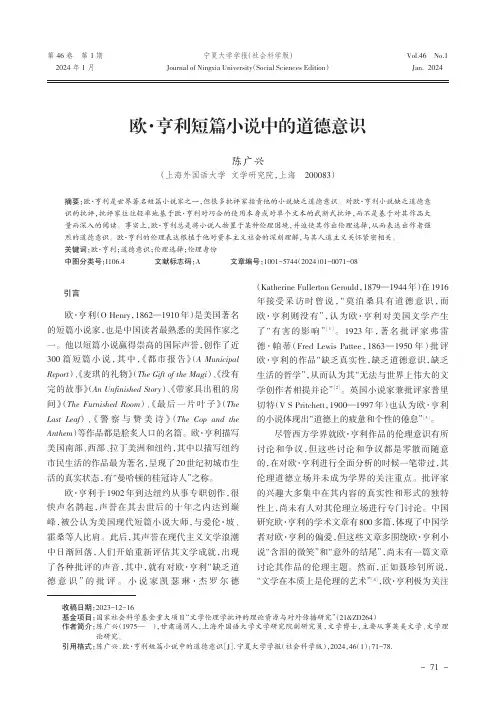
第 46 卷第 1 期2024 年 1 月Vol.46 No.1Jan. 2024宁夏大学学报(社会科学版)Journal of Ningxia University(Social Sciences Edition)欧·亨利短篇小说中的道德意识陈广兴(上海外国语大学文学研究院,上海200083)摘要:欧·亨利是世界著名短篇小说家之一,但很多批评家指责他的小说缺乏道德意识。
对欧·亨利小说缺乏道德意识的批评,批评家往往轻率地基于欧·亨利对巧合的使用本身或对单个文本的武断式批评,而不是基于对其作品大量而深入的阅读。
事实上,欧·亨利总是将小说人物置于某种伦理困境,并迫使其作出伦理选择,从而表达出作者强烈的道德意识。
欧·亨利的伦理表达根植于他对资本主义社会的深刻理解,与其人道主义关怀紧密相关。
关键词:欧·亨利;道德意识;伦理选择;伦理身份中图分类号:I106.4 文献标志码:A 文章编号:1001-5744(2024)01-0071-08引言欧·亨利(O Henry,1862—1910年)是美国著名的短篇小说家,也是中国读者最熟悉的美国作家之一。
他以短篇小说赢得崇高的国际声誉,创作了近300篇短篇小说,其中,《都市报告》(A Municipal Report)、《麦琪的礼物》(The Gift of the Magi)、《没有完的故事》(An Unfinished Story)、《带家具出租的房间》(The Furnished Room)、《最后一片叶子》(The Last Leaf)、《警察与赞美诗》(The Cop and the Anthem)等作品都是脍炙人口的名篇。
欧·亨利描写美国南部、西部、拉丁美洲和纽约,其中以描写纽约市民生活的作品最为著名,呈现了20世纪初城市生活的真实状态,有“曼哈顿的桂冠诗人”之称。
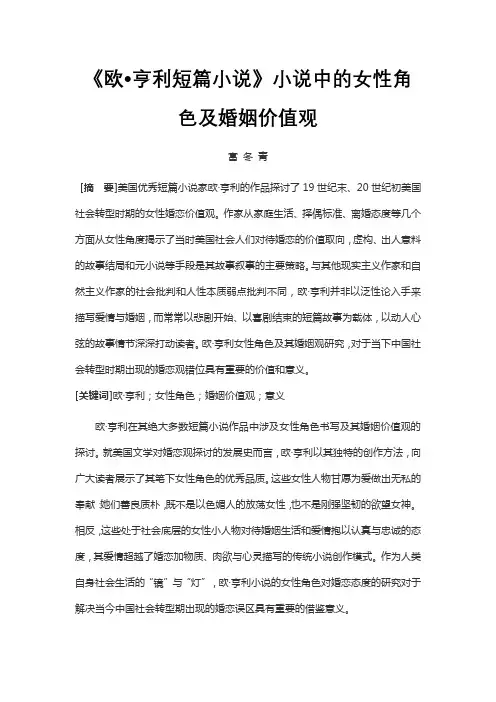
《欧•亨利短篇小说》小说中的女性角色及婚姻价值观富冬青[摘要]美国优秀短篇小说家欧·亨利的作品探讨了19世纪末、20世纪初美国社会转型时期的女性婚恋价值观。
作家从家庭生活、择偶标准、离婚态度等几个方面从女性角度揭示了当时美国社会人们对待婚恋的价值取向,虚构、出人意料的故事结局和元小说等手段是其故事叙事的主要策略。
与其他现实主义作家和自然主义作家的社会批判和人性本质弱点批判不同,欧·亨利并非以泛性论入手来描写爱情与婚姻,而常常以悲剧开始、以喜剧结束的短篇故事为载体,以动人心弦的故事情节深深打动读者。
欧·亨利女性角色及其婚姻观研究,对于当下中国社会转型时期出现的婚恋观错位具有重要的价值和意义。
[关键词]欧·亨利;女性角色;婚姻价值观;意义欧·亨利在其绝大多数短篇小说作品中涉及女性角色书写及其婚姻价值观的探讨。
就美国文学对婚恋观探讨的发展史而言,欧·亨利以其独特的创作方法,向广大读者展示了其笔下女性角色的优秀品质。
这些女性人物甘愿为爱做出无私的奉献:她们善良质朴,既不是以色媚人的放荡女性,也不是刚强坚韧的欲望女神。
相反,这些处于社会底层的女性小人物对待婚姻生活和爱情抱以认真与忠诚的态度,其爱情超越了婚恋加物质、肉欲与心灵描写的传统小说创作模式。
作为人类自身社会生活的“镜”与“灯”,欧·亨利小说的女性角色对婚恋态度的研究对于解决当今中国社会转型期出现的婚恋误区具有重要的借鉴意义。
一、对女性文学传统的继承与发展欧·亨利作为现实主义作家,在世界短篇小说发展史上占据重要位置,其女性角色书写对于广大读者了解美国社会转型时期的婚姻观而言,具有重要的理论意义和实践价值。
然而,国内外对欧·亨利小说女性角色书写及其婚姻价值观未给予应有的重视。
文学对人的关注,关键在于人的自然存在走向了社会存在,其核心在于社会结构中形成的各种人际关系,而社会的最小单位“家庭”则是这些关系中更为重要的一环。
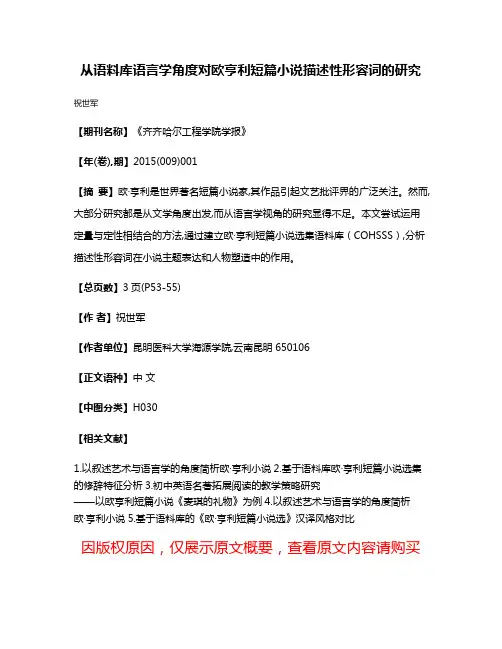
从语料库语言学角度对欧亨利短篇小说描述性形容词的研究祝世军
【期刊名称】《齐齐哈尔工程学院学报》
【年(卷),期】2015(009)001
【摘要】欧·亨利是世界著名短篇小说家,其作品引起文艺批评界的广泛关注。
然而,大部分研究都是从文学角度出发,而从语言学视角的研究显得不足。
本文尝试运用定量与定性相结合的方法,通过建立欧·亨利短篇小说选集语料库(COHSSS),分析描述性形容词在小说主题表达和人物塑造中的作用。
【总页数】3页(P53-55)
【作者】祝世军
【作者单位】昆明医科大学海源学院,云南昆明650106
【正文语种】中文
【中图分类】H030
【相关文献】
1.以叙述艺术与语言学的角度简析欧·亨利小说
2.基于语料库欧·亨利短篇小说选集的修辞特征分析
3.初中英语名著拓展阅读的教学策略研究
——以欧亨利短篇小说《麦琪的礼物》为例4.以叙述艺术与语言学的角度简析欧·亨利小说5.基于语料库的《欧·亨利短篇小说选》汉译风格对比
因版权原因,仅展示原文概要,查看原文内容请购买。

美国现实主义作家欧亨利短篇小说中的讽刺与反讽1. 引言美国现实主义是19世纪末至20世纪初兴起的一种文学流派,其特点是对社会现实进行揭示和批判。
在这个时期,欧亨利(O. Henry)被公认为最重要的短篇小说作家之一。
他的作品以幽默、机智、诙谐而著称,在其中使用了讽刺和反讽手法来传达对社会问题和人性的见解。
2. 讽刺与反讽的定义2.1 讽刺•定义:通过嘲笑或嘲弄来暴露事物的荒谬、可悲或错误。
•功能:揭示社会问题、强调不合理之处、引起读者思考。
2.2 反讽•定义:通过将期待与现实相对比来产生意想不到的效果。
•功能:批评并颠覆成见、突出人们行为背后的虚伪或偏差。
3. 欧亨利短篇小说中的讽刺3.1《礼品奇遇》("The Gift of the Magi")•故事概述:一个贫穷的夫妇分别为配对的圣诞礼物而牺牲了自己最宝贵的东西。
•讽刺之处:他们的举动被揭示为多余和荒谬,因为他们最终失去了他们原本想要给对方的礼物。
3.2《超然市场》("A Municipal Report")•故事概述:一位作家受雇写一篇描写小城故事的文章,但最后决定揭露市政府腐败的秘密。
•讽刺之处:作家最初只是想编写一篇中性的报道,但在与市政府互动时,不得不面对腐败和恶行。
3.3《缺名侦探》("A Retrieved Reformation")•故事概述:一个盗贼变成了一个法律遵从者,并为了拯救曾经爱过的女人而回到犯罪生涯。
•讽刺之处:主人公本来打算过上清白正直的生活,但面临困境时,他再次选择犯罪这条路。
4. 欧亨利短篇小说中的反讽4.1《最后一片叶子》("The Last Leaf")•故事概述:一位艺术家用他最后一片树叶的存在来挽救一个生病的女孩的生命。
•反讽之处:艺术家自己的牺牲实际上是不必要的,因为他只相信树叶,而女孩最终因其他原因恢复了健康。
4.2《问卷调查》("After Twenty Years")•故事概述:两个老朋友在约定的地点见面,但其中一个已经成了警察并逮捕了另一个犯罪分子。
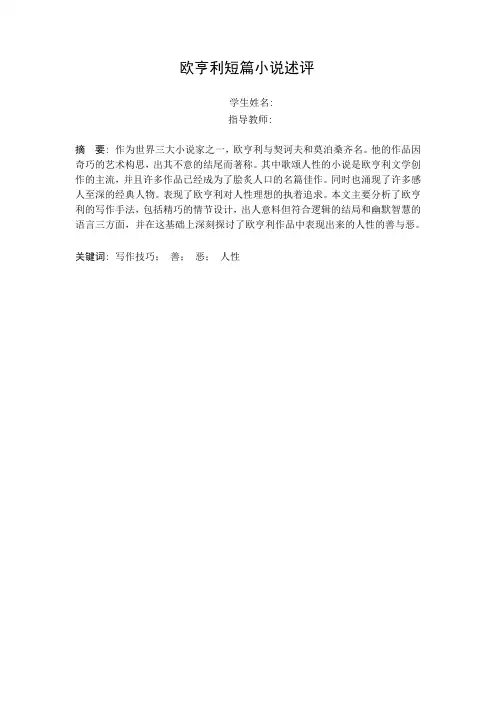
欧亨利短篇小说述评学生姓名:指导教师:摘要:作为世界三大小说家之一,欧亨利与契诃夫和莫泊桑齐名。
他的作品因奇巧的艺术构思,出其不意的结尾而著称。
其中歌颂人性的小说是欧亨利文学创作的主流,并且许多作品已经成为了脍炙人口的名篇佳作。
同时也涌现了许多感人至深的经典人物。
表现了欧亨利对人性理想的执着追求。
本文主要分析了欧亨利的写作手法,包括精巧的情节设计,出人意料但符合逻辑的结局和幽默智慧的语言三方面,并在这基础上深刻探讨了欧亨利作品中表现出来的人性的善与恶。
关键词: 写作技巧;善;恶;人性A Brief Comment on O’ Henry’s Short StoriesUndergraduate:Supervisor:Abstract: O. Henry, one of the three most famous short-story writers in the world, enjoys equal status with Chekhov and Maupassant. Exquisite plot, wry humor and twist ending dominate his works. The main stream of his works is eulogy of humanity and his many classical works are notable. This thesis mainly analyses O. Henry’s writing style including technique plot making, surprising but logical ending and humorous and witty tone, then deeply analyses the human virtues and defects reflected in O. Henry’s works.Key Words: artistic styles; virtues; defects; human characterContents1. Introduction (1)2. Unique artistic style (1)2.1 Technique plot making (1)2.2 Surprising but logical ending (3)2.3 Humorous and witty tone (4)3. The humanity of character (4)4. Conclusion (7)Bibliography (9)Acknowledgment (10)1. IntroductionO. Henry, originally named William Sydney Porter, is a distinguished American storywriter. He wrote more than 300 short stories in his life. His stories are full of colorful characters. He creates an original, typically American democratic form of short stories with, at its best, a valuable critical awareness of life and society tellingly expressed through humor. Therefore, some critics c all him “the founder of American stories”. Being gifted with humor and a keen awareness of details, he objectively shows us what America looks like. All his stories putting together constitute a true panorama of American life.This thesis mainly emphasizes O. Henry’s unique artistic styles and the human characters. It includes two main aspects. Part one is on the unique artistic styles. O. Henry is a good plot maker, he shows readers the real life of American people by giving people a surprising but logical ending through a plausible plot making using humor and witty tone which gives readers a new open sight. Part two stresses on the human nature that contains the virtues and defects sides. In a capitalist society, the specific characters are the special society. O. Henry shows people clearly in his works.2. Unique artistic styleO. Henry's trademark is the surprising ending that each of his stories contains. He sets a story moving in one direction, and just when the reader is convinced of the general direction of the narrative, the story will be completely reversed. And if we look back to the total story, the ending seems logical and plausible. As a “plot-maker”, and designer of incident, he is an amazing genius. No one can do better than him to holds the reader in “suspense”. More than that, the reader scarcely knows that he is suspended until the very close of the story. Just as turns on the lights and the whole tale is revealed in its entirety. He uses this device of dramatic and humorous effect in the short story collection The Four Million which including “The Ransom of Red Chief ”, “The Gift of the Magi ”, and“The Cop and the Anthem”, “the Service of Love”, “The last Leaf.” He uses compact and vivid language to set a plot and portray the plot through humorous and witty tone.2.1 Technique plot makingThe short story is the one fundamental and self-contained genre in American prose fiction, and the stories of O. Henry certainly makes their appearances in consequence of the prolonged and incessant cult ivation of the genre. As a “plot maker”, he is an amazing genius. No one can better him in holding the reader in “suspense”. More than that, the reader scarcely knows that he is suspended, until atthe very close of the story. O. Henry deliberately designs the little tricks with words, for he is a master of language and not its slave.The typical feature of O. Hen ry’s stories is a twist of plot. His ultimate achievement is to create the twist ending by the plot making and compact structure. He arranges a story moving in one direction, and just when the reader is going to be convinced of the general direction of the narrative, which he takes for granted, the story is completely reversed.For example, in “The Ransom of Red Chief”, two kidnappers, Sam and Bill make off with the little son of a prominent man. According to the general expectation, readers m ay assume that they will either obtain the ransom from the boy’s father or kill the boy in the end. But the plot is totally different. The boy is such a nuisance that they agree to pay the boy’s father to take him back because they can’t stand him anymore. Although the plot far exceeds expectations, readers appreciate the cleverness of plot situation and ending a great deal while enjoying the delight of reading.In O. Henry’s works, the events of some short stories are arranged in the specific order which e xceed reader’s normal expectation to the arrangement of those events in his works, make the ending unpredictable and strange. O. Henry deliberately designs the little tricks with words, for he is a master of language and not its slave.The suspense in the story is usually employed in the plot. It is the seemingly insignificant characters that finally become the notable figures that rouse readers ponder. In “The Last Leaf”, Mr.Behrman who is only mentioned in only a short paragraph in the middle of the story to show who he is, and two paragraph tell the reader his rage about Sue ’s fully thought. The main theme of the story is that Sue takes the last fallen ivy leaf as the end of her life. Before they know the end, readers will no doubt ask some questions. Ho w does Sue’s illness? Why does the leaf stick against the wall? Does the leaf fall down? Does Sue die? Why does the author mention Mr.Behrman? The last paragraph reveals. All suspense dissolves. The leave is painted by Behrman, while Sue lives. But the old painter died in hopeless pain by Pneumonia, or rather, to rescue Sue. He has to withstand tough wind and heavy shower and the life-long masterpiece paid off by his life. When we find the plausibility of ending in the previous passage, when Mr. Pneumonia wais called in, the Johsey scarcely moves, only looking through the small Dutch windowpanes at the blank side of the next brick house, the “blank side” of brick later provides the location for Mr.Behrman’s masterpiece, the description of Mr.Behrman. He is p ast 60 and has a Micheal Angeo’s Moses beard curling down from the head of a satyr along the body of an imp. “Micheal Angeo’s Moses” leaves readers an impression of artistic potential. “Imp” can explain why he was so weak to fight against disease.The comp act structure is O. Henry’s outstanding writing technique. Events in the story are closely connected as chains of rings, which make readers eagerly interested in the ending of the story. As soon as the high light of the reverse of plots, the story ends wit hout any redundant explanations. In “The Last Leaf”, the description of Mr.Behrman, the true hero, only takes up 500 words in more than 5000 words. Meanwhile, the story dismisses a part, rousing us readers a great deal of imagination: How can old man, above 60 years old stand on the ladder, drawing a leaf on the wall in the dreadfully storming night, while his “shoes and clothing were wet t hrough and icy cold.”?Therefore, the main stream of O. Henry’s works is easily perceived: the suspense in addition to wry humor ending is his main rhetoric method.2.2 Surprising but logical endingThe ending of an article has long been considered as a conclusion or just a summary of the whole passage. However, O. Henry illustrates a new way, the so-called twist ending or sometimes the O. Henry’s ending. It means that at the end of an article the mental status or the fate of the character has changed greatly. But the whole passage is suddenly endowed with a great charm because of the ending. The author has your nerves all a quiver until the last sentence. The surprise comes quickly and the story is finished. O. Henry is such a master of the unexpected ending that one must admire his skills.In the story The Cop and the Anthem, Soapy, a homeless tramp, deciding to be sent to the prison on the Island which he called his winter quarter against the rigor and the hunger, attempted to practice several illegal activities for the purpose of “wooing capture”;(O, Henry 2004: 09) but the cop, who stood nearby when Soapy was trying to attract his attention by his anti-law behavior, paid no special attention to Soapy every time, even “seemed to regard him as a king who could do no wrong”. (O, Henry 2004: 09) Developing up here, the story must give the reader the conclusion that Soapy had to go back disappointedly to his home—a park bench. On his way, the sweet music of anthem from the church played by the organist and the beautiful moonlight scenery “wrought a sudden and wonderful change in his soul”, (O, Henry 2004: 10) he made up his mind to “pull himself out of the mire”(O, Henry 2004: 10)and “make a man of himself again”. (O, Henry 2004: 10) Moving like this, the plot is not completely understandable at once. When the reader is puzzled about the use and meaning of growing plot, and just while Soapy was planning his tomorrow’s action for being “somebody in the world”, (O, Henry 2004: 11) an unforeseen plot, and just while abruptly: he was arrested because a policeman thought him doubtful, and the next day he was sentence to “three months on the Island”. (O, Henry 2004: 11) The story stops here suddenly in spite of the reader’s not immediate understanding. But after a moment of consideration, the reader’s surprise turns into admiration for hisastonishing contrivance of tricky ending which reveals rigorously the real facts of reversal between truth and falsehood in capitalist society which confuses right and wrong.2.3 Humorous and witty toneO. Henry, a great designer, is skillful enough to dye some color of pink in a tragedy, or kind of sadness in comedy. O. Henry’s stories are humorous encyclopedia of American life. This means that this work is full of various humors, sometimes even with exaggeration. It fully discloses the essence of American society: the weak are the prey of the strong, which is regarded as the law of the jungle universally. Right and wrong are confused, good and evil are disordered; Materialism and individualism dominate people’s mind. This writing technique makes his work enjoy the fame of “Smile with Tears”.The humorous paragraph describes the congested conditions of a room where the hero and heroin live in the “The Service of Love”, the story tells of an earnest young pair of art students, the Lattabees, who prop up each other’s courage when their funds run out by pretending to have lucked into a steady income from their professional skill in painting and music. But it turns out that Delia’s service has been ironing shirts in a laundry while Joe has been firing the furnace in the same building. Readers are not surprised to find out how precious their genuine love for each other is. Monetarily they were poor, but they are mentally wealthy. We may laugh with tears after finishing reading the story. O. Henry carries an abundant good humor with hum and sees the bright and amusing side of things. O. Henry is not the comic wit that explodes the reader into a huge guffaw of laughter and vanishes. His humor and twist ending are of that deep quality that smiles at life itself and mingles our amusement with our tears.Such examples can be found throughout the story. These sentences seem to be talked about very casually to make the story appear to be a comedy. But meanwhile, we can also feel the sadness and helplessness of the hero Soapy. Readers are seduced by humor language and stories plots step by step, but finally cannot help laughing, but with pitiful tears.3. The humanity of characterAmong O. Henry’s short stories, the eternal theme proves to be the humanity. Whether simple or complex, the mystery of human motives controlled by human nature is exposed. There are good and evil elements in human nature, for the two are often mixed with each other more or less. When the good elements in human nature occupy the predominant portion, man will carry forward his virtues such as kindness, generosity, hospitality, self-sacrifice for love and friendship, helping others without asking for rewards. While the evil things defeat the good in human nature, man willdisplay such human defects as being gluttonous and lazy, rapacious, officious, vain arrogant, cowardly, impetuous etc. The human motives become more and more mysterious and various. When tempted, good man would do evil things; when moved by noble-minded people or touching things, the demon will forsake darkness for light and turn over a new leaf in his life. In O. Henry's world, established figures become boobs and rich men become dunces, while rogues become heroes and down-and-outers become gentlemen.3.1 The human virtuesHuman being has many virtues from ancient times to the present. They are kind, brave, honest, hard working, polite, thrifty, generous, hospital and so on. Some people still pay a great deal in order to maintain these virtues, they sacrifice their own happiness even their life for lofty love and friendship; they help others without asking for rewards and regard it as a pleasure; they give up their own treasure and chance to others etc. Such people bring love and fine things to the world; they are the ones who endow the world with light and hope. O. Henry has a great understanding of the trials of the lower class, and he frequently pictures the lives of ordinary people of early twentieth century America with warm and sympathetic colors. These characters are frequently the overlooked: the struggling shops girl, the unsuccessful artist, and the impoverished. Even Theodore Roosevelt said: “It was O. Henry who started me on my cam paign for office girls.” There is no denying that the narratives of humanity by O. Henry have everlasting influence. Although they are poor, le ading the life “made up of sobs, sniffles, and smiles, with sniffles pre dominating”,they still think, “If a home is happy i t cannot fit too close.”Most of O. Henry’s stories show that the humble little insignificant people of New York are just as admirable and their lives are as worthy of attention and interest and, as he implies, as respectable as the members of the Four Hundred.Take “The Gift of the Magi” as an example, we will find the ingenuity of O. Henry’s unexpected endings. From that condensation of the charm of human virtues the love-sacrificial theme is shown. It is about a young couple that is short of money but desperately wants to buy each other Christmas gifts. Unknown to Jim, Della sells her most valuable possession, her beautiful hair, in order to buy platinum as the chain for Jim's watch; unknown to Della, Jim sells his most valuable possession, his watch, to buy jeweled combs for Della's hair. The author arranges the entire plot just to get the readers to wait, to cause suspense, the pleasurable excitement and anticipation of the outcome. From the beginning, the readers keep guessing what Jim and Della will buy for each other, and the coincidence of their gift is the great suspense the author put in his article. And then he gives the answer to the question. Here is the ending: “Here I have lamely related to you the uneventful chronicle of two foolish children ina flat who most unwisely scarified for each other the greatest treasures of their house. But in the last word to the wise of these days let it be said tha t of all who give gifts.” (O, Henry 2004: 35) However, the story end comes when Jim reveals that he has sold his watch to buy Dalla her present, from where the poor couple’s love is show. Therefore, O. Henry ends the story artfully, and with deft touches he elicits the reader’s admiration and sympathy for his young couple shows love for each other more than compensates for their lack of money and material possessions. Though confronted with cruel reality and dull daily routine, Della and Jim can never change their eagerness toward love. To them the most valuable material possession is so slight and insignificant before the spiritual possession of love romance. That is sparkling with fragrant charm.There is another story about sacrifi cial theme entitled “The Last Leaf”, a warm and tragic tale describing how a dying artist proves as resilient as the last leaf on the wall outside. Sue, a poor painter, attacked by Pneumonia, wanted to turn loose her hold on everything, and go sailing down, just like one of those poor tires leave. But after beating rain and fierce gusts of wind, an ivy leaf still stands against the brick wall, which gives her the hope of living, mak ing her realize that: “It is a sin to want to die”. The ending reveals that Mr. Behrman, a kind old artist dies at previous night by pneumonia, painting the leave on an outdoor vine in the storming night ----in his effort to restore Sue’s will to live. Though the touching ending makes us absorbed in sadness, the readers can still find gleams of hope and desire out of despair. It not only enlightens the girl’s courage for better life but also moves every reader to tears. Those glittering human virtues however counterpoint to the capitalist industrial bourgeoisies’ human defeats, telling us that life is supreme and thus upgrading the theme.By and large, through the portrayal the panorama of a throng of people either of upper class or lower class, O. Henry’s eulogize the specious and precious human virtues.3.2 The human defectsOn the other hand, human beings have many defects, too. They benefit themselves at the expense of others. In order to make money they never show mercy and sympathy to the poor. They realize their own aims by hook or by crook. Their evil deeds make the world vicious. By exposing the human defects and the dark side of the world, O. Henry wants to awaken people’s conscience and their deepest desire for all good things, so that people can make their efforts to save and clean the whole world. Some people love money than anything else. In “Mammon and the Archer”, Anthony Fuckwell, a retired manufacturer and proprietor of Rockwall’ Soap, has the greatest esteem for the value of money. “I bet my money on money every time, I’ve been through the encyclopedia down to Y loo king for something you can’t buy with it, andI expect to have to take to the appendix next week, I’m for money against the field. Tell me something money won’t buy. ” (O, Henry 2004: 113) His son wants to ask for a girl’s hand but there is too little time left. Surprisingly, a fortunately traffic tie-up offers enough time for the son. But the ending discloses that it is the father who makes the accident in order to help his son to win the girl’s heart. The theme of the story come out: confronted with the Mammon even Archer has to be bent his head down. To Anthony and his peers, the only thing worthy of their thought is money. With the ironic rhetoric method, O. Henry ends the story with a fat boy without any clothes on shooting arrow around with a bow. That is pictured Cupid, in a new, unexpected way, thus bringing readers a new sense to the topic “Mammon and the Archer”. This usage of the twist ending adds artistic effect to the person’s character described.In a capitalist society, many people even do evil things against their conscience, so as to earn money. In “The Furnished Room”, the housekeeper, Mrs. Purdy, cheats a young man who is seeking his lover, in order to let him rent the room. Then the young man commits suicide out of despair. At the end, after the young man dies, we find the man’s lover commit suicide at the same rented room. Mrs.Purdy talks about it with another housekeeper in an indifferent tone as if it were only a trifle that could be the topic for gossip over dinner. The society is so doomed by an atmosphere of gloom and indifference that it makes people treat others or even friends without sympathy, equaling to committing murder.In “The Romance of a Busy Broker”, the businessman Maxwell is so crazy about his golden eternal business- make big money against the clock. More than that he even forgets he has married or not. And in a tumult of a preparation out of his work, he asks his wife to marry again. Those twist ending exploses the whole theme of the article. Are the readers to deride the broker or to show sympathy for the broker’s tender wife?The author uses pungent rhetoric methods not only to show us the humanity vividly, but also to enhance the theme: the gluttonous and cruel side of those bourgeoisies.4. ConclusionO. Henry focuses on the poverty-stricken life and spiritual depression of common people. He takes great sympathy on them, with dissatisfaction with the greediness of the rich and the noble. O. Henry is adept at seizing and grasping the typical scenes in life, in which each episode of the life of the characters that had been in dilemma and confronted fatal decision was presented. Through this, he not only chiefly portrays the hero’s mentality but also fully reveals the inner contradiction of life. Finally, the human virtues and defects emerge from the twist ending. That notonly arouses readers ponder about the humanity but also earns O. Henry’s story fame of “smile with tears”. Henry not only widens the experience of his readers, he also restates the verities that exist wherever people continue to strive for truth and beauty in life. The humanity reflected from the twist ending makes his stories at their best an influence for the furthering of those ideals that still tend to command the allegiance of civilized men. O. Henry is the “founder of American stories”. His works are like a mirror of American society at that time. A multiple of reflections are rippling through the years passing by. The plots in O. Henry’s works appear to be nothing special at first glance. Nevertheless, read those to the ending and you will find something unusual out of what seems to be too ordinary. His works are full of depth in portraying an unfathomable humanity of character.In a nutshell, O. Henry’s artistic charms will everlast and be vie wed as a perpetual encyclopedia of American life.Bibliography[1] Medrick, Fred. An introduction to American literature[M]. Henan University Press,1985[2] Hudson, Long. O Henry The Man and His Work[C]. New York:Russell and Russell,1969[3] O, Henry, Heart of the West[M]. New York: McClure, 1907[4] O, Henry, The Four Million[M]. New York: Dobleday, Doran and Company. 1906 P68[5] O, Henry, 欧亨利短篇小说[M].青海:青海出版社,2004[6] 李国宁. 欧亨利式结尾的艺术魅力[M]. 北京:清华大学出版社,2003[7] 李遇溪. 外国文学名著赏析词典[M]. 杭州:浙江文艺出版社,1988[8] 欧亨利. 四百万[M]. 北京:外语教学与研究出版社,1988[9] 荣四才. 欧亨利与欧亨利奖[J]. 外国文学. 1993(6):34-35[10] 吴伟仁. 美国文学史及选读[M]. 北京:外语教学与研究出版社,1990[11] 魏春艺. 欧亨利小说人性世界面面观[J]. 丹东师专学报,2003,P28[12] 赵书颖. “含泪的笑”与“含笑的泪”浅析欧·亨利的主题[J].黑龙江教育学院学报, 2004〈3〉. P66[13] 赵丽,黄春妮. 欧亨利作品导读[M]. 武汉: 武汉大学出版社 2003 P3AcknowledgmentAt the point of finishing this paper, I’d like to express my sincere thanks to all those who have given me hands in the course of my writing this paper. First of all, I'd like to take this opportunity to show my sincere gratitude to my supervisor, Ms. Wang Xiaoyun, who has given me so much useful advices on my writing, and has tried her best to improve my paper. Secondly, I’d like to express my gratitude to my classmates who offered me references and information on time. Last but not least, I’d like to thank those leaders, teachers and working staff in Mianyang Normal University and especially those in the School of Foreign Languages. Without their help, it would be much harder for me to finish my study this paper.。
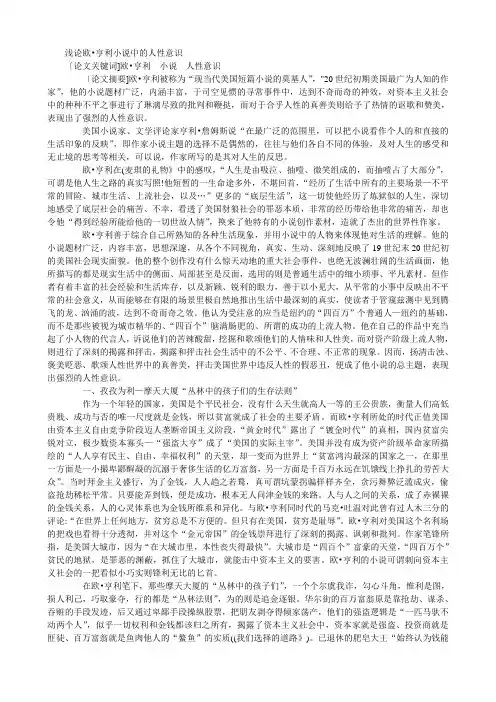
浅论欧•亨利小说中的人性意识〔论文关键词]欧•亨利小说人性意识〔论文摘要]欧•亨利被称为“现当代美国短篇小说的莫基人”,"20世纪初期美国最广为人知的作家”,他的小说题材广泛,内涵丰富,于司空见惯的寻常事件中,达到不奇而奇的神效,对资本主义社会中的种种不平之事进行了琳漓尽致的批判和鞭挞,而对于合乎人性的真善美则给予了热情的讴歌和赞美,表现出了强烈的人性意识。
美国小说家、文学评论家亨利•詹姆斯说“在最广泛的范围里,可以把小说看作个人的和直接的生活印象的反映”,即作家小说主题的选择不是偶然的,往往与他们各自不同的体验,及对人生的感受和无止境的思考等相关,可以说,作家所写的是其对人生的反思。
欧•亨利在(麦琪的礼物》中的感叹,“人生是由吸泣、抽噎、微笑组成的,而抽噎占了大部分”,可谓是他人生之路的真实写照!他短暂的一生命途多外,不堪回首,“经历了生活中所有的主要场景—不平常的冒险、城市生活、上流社会,以及…”更多的“底层生活”,这一切使他经历了炼狱似的人生,深切地感受了底层社会的痛苦、不幸,看透了美国豺狼社会的罪恶本质,非常的经历带给他非常的痛苦,却也令他“得到经验所能给他的一切世故人情”,换来了他特有的小说创作素材,造就了杰出的世界性作家。
欧•亨利善于综合自己所熟知的各种生活现象,并用小说中的人物来体现他对生活的理解。
他的小说题材广泛,内容丰富,思想深邃,从各个不同视角,真实、生动、深刻地反映了19世纪末20世纪初的美国社会现实面貌。
他的整个创作没有什么惊天动地的重大社会事件,也绝无波澜壮阔的生活画面,他所描写的都是现实生活中的侧面、局部甚至是反面,选用的则是普通生活中的细小琐事、平凡素材。
但作者有着丰富的社会经验和生活库存,以及新颖、锐利的眼力,善于以小见大,从平常的小事中反映出不平常的社会意义,从而能够在有限的场景里极自然地推出生活中最深刻的真实,使读者于管窥兹测中见到腾飞的龙、汹涌的波,达到不奇而奇之效。
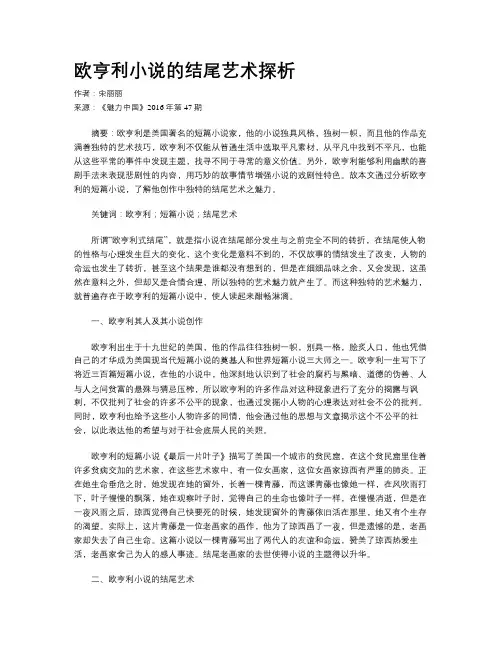
欧亨利小说的结尾艺术探析作者:宋丽丽来源:《魅力中国》2016年第47期摘要:欧亨利是美国著名的短篇小说家,他的小说独具风格,独树一帜,而且他的作品充满着独特的艺术技巧,欧亨利不仅能从普通生活中选取平凡素材,从平凡中找到不平凡,也能从这些平常的事件中发现主题,找寻不同于寻常的意义价值。
另外,欧亨利能够利用幽默的喜剧手法来表现悲剧性的内容,用巧妙的故事情节增强小说的戏剧性特色。
故本文通过分析欧亨利的短篇小说,了解他创作中独特的结尾艺术之魅力。
关键词:欧亨利;短篇小说;结尾艺术所谓“欧亨利式结尾”,就是指小说在结尾部分发生与之前完全不同的转折,在结尾使人物的性格与心理发生巨大的变化,这个变化是意料不到的,不仅故事的情结发生了改变,人物的命运也发生了转折,甚至这个结果是谁都没有想到的,但是在细细品味之余,又会发现,这虽然在意料之外,但却又是合情合理,所以独特的艺术魅力就产生了。
而这种独特的艺术魅力,就普遍存在于欧亨利的短篇小说中,使人读起来酣畅淋漓。
一、欧亨利其人及其小说创作欧亨利出生于十九世纪的美国,他的作品往往独树一帜,别具一格,脍炙人口,他也凭借自己的才华成为美国现当代短篇小说的奠基人和世界短篇小说三大师之一。
欧亨利一生写下了将近三百篇短篇小说,在他的小说中,他深刻地认识到了社会的腐朽与黑暗、道德的伪善、人与人之间贫富的悬殊与猜忌压榨,所以欧亨利的许多作品对这种现象进行了充分的揭露与讽刺,不仅批判了社会的许多不公平的现象,也通过发掘小人物的心理表达对社会不公的批判。
同时,欧亨利也给予这些小人物许多的同情,他会通过他的思想与文章揭示这个不公平的社会,以此表达他的希望与对于社会底层人民的关照。
欧亨利的短篇小说《最后一片叶子》描写了美国一个城市的贫民窟,在这个贫民窟里住着许多贫病交加的艺术家,在这些艺术家中,有一位女画家,这位女画家琼西有严重的肺炎。
正在她生命垂危之时,她发现在她的窗外,长着一棵青藤,而这课青藤也像她一样,在风吹雨打下,叶子慢慢的飘落,她在观察叶子时,觉得自己的生命也像叶子一样,在慢慢消逝,但是在一夜风雨之后,琼西觉得自己快要死的时候,她发现窗外的青藤依旧活在那里,她又有个生存的渴望。
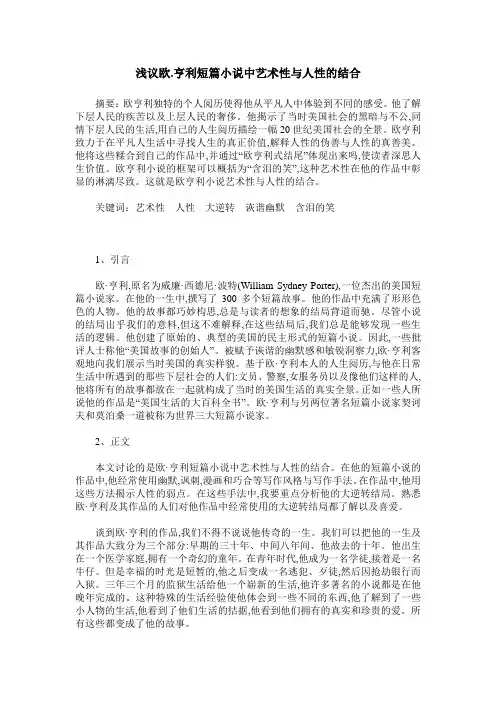
浅议欧.亨利短篇小说中艺术性与人性的结合摘要:欧亨利独特的个人阅历使得他从平凡人中体验到不同的感受。
他了解下层人民的疾苦以及上层人民的奢侈。
他揭示了当时美国社会的黑暗与不公,同情下层人民的生活,用自己的人生阅历描绘一幅20世纪美国社会的全景。
欧亨利致力于在平凡人生活中寻找人生的真正价值,解释人性的伪善与人性的真善美。
他将这些糅合到自己的作品中,并通过“欧亨利式结尾”体现出来吗,使读者深思人生价值。
欧亨利小说的框架可以概括为“含泪的笑”,这种艺术性在他的作品中彰显的淋漓尽致。
这就是欧亨利小说艺术性与人性的结合。
关键词:艺术性人性大逆转诙谐幽默含泪的笑1、引言欧·亨利,原名为威廉·西德尼·波特(William Sydney Porter),一位杰出的美国短篇小说家。
在他的一生中,撰写了300多个短篇故事。
他的作品中充满了形形色色的人物。
他的故事都巧妙构思,总是与读者的想象的结局背道而驰。
尽管小说的结局出乎我们的意料,但这不难解释,在这些结局后,我们总是能够发现一些生活的逻辑。
他创建了原始的、典型的美国的民主形式的短篇小说。
因此,一些批评人士称他“美国故事的创始人”。
被赋予诙谐的幽默感和敏锐洞察力,欧·亨利客观地向我们展示当时美国的真实样貌。
基于欧·亨利本人的人生阅历,与他在日常生活中所遇到的那些下层社会的人们:文员、警察,女服务员以及像他们这样的人,他将所有的故事都放在一起就构成了当时的美国生活的真实全景。
正如一些人所说他的作品是“美国生活的大百科全书”。
欧·亨利与另两位著名短篇小说家契诃夫和莫泊桑一道被称为世界三大短篇小说家。
2、正文本文讨论的是欧·亨利短篇小说中艺术性与人性的结合。
在他的短篇小说的作品中,他经常使用幽默,讽刺,漫画和巧合等写作风格与写作手法。
在作品中,他用这些方法揭示人性的弱点。
在这些手法中,我要重点分析他的大逆转结局。
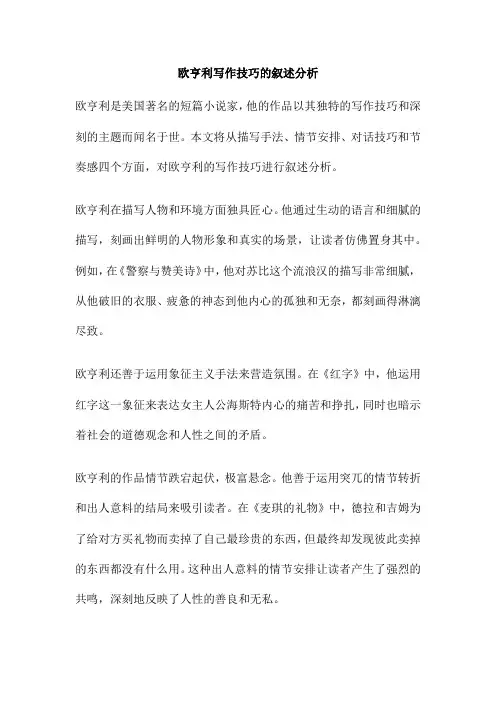
欧亨利写作技巧的叙述分析欧亨利是美国著名的短篇小说家,他的作品以其独特的写作技巧和深刻的主题而闻名于世。
本文将从描写手法、情节安排、对话技巧和节奏感四个方面,对欧亨利的写作技巧进行叙述分析。
欧亨利在描写人物和环境方面独具匠心。
他通过生动的语言和细腻的描写,刻画出鲜明的人物形象和真实的场景,让读者仿佛置身其中。
例如,在《警察与赞美诗》中,他对苏比这个流浪汉的描写非常细腻,从他破旧的衣服、疲惫的神态到他内心的孤独和无奈,都刻画得淋漓尽致。
欧亨利还善于运用象征主义手法来营造氛围。
在《红字》中,他运用红字这一象征来表达女主人公海斯特内心的痛苦和挣扎,同时也暗示着社会的道德观念和人性之间的矛盾。
欧亨利的作品情节跌宕起伏,极富悬念。
他善于运用突兀的情节转折和出人意料的结局来吸引读者。
在《麦琪的礼物》中,德拉和吉姆为了给对方买礼物而卖掉了自己最珍贵的东西,但最终却发现彼此卖掉的东西都没有什么用。
这种出人意料的情节安排让读者产生了强烈的共鸣,深刻地反映了人性的善良和无私。
欧亨利还善于运用线索来引导读者。
在《罗宾逊医生的诊断》中,他巧妙地安排了一条隐藏的线索,直到故事的高潮才揭示出来,让读者恍然大悟。
这种情节安排不仅增加了故事的趣味性,也加深了读者对故事的理解。
欧亨利的作品中的对话非常生动、真实,具有鲜明的个性特点。
他通过对话来推动故事发展,表现人物性格和塑造形象。
在《麦琪的礼物》中,德拉和吉姆之间的对话生动地表现了他们的性格特点和情感交流。
欧亨利的对话也具有很强的节奏感和张力。
在《警察与赞美诗》中,警察与苏比之间的对话紧张而引人入胜,不仅推动了故事的发展,也表现了警察和苏比之间的矛盾和冲突。
欧亨利的作品节奏感非常出色,他通过节奏感的运用让文章更加流畅、引人入胜。
在《麦琪的礼物》中,故事的节奏逐渐加快,直到最后达到高潮,这种节奏感的运用让读者看得非常过瘾。
欧亨利的作品中的铺垫也非常到位。
在《警察与赞美诗》中,他通过一系列的事件来铺垫苏比想要进入监狱的想法,然后在故事的高潮部分才揭示出苏比真正想要做的事情,这种铺垫让故事更加真实、可信。
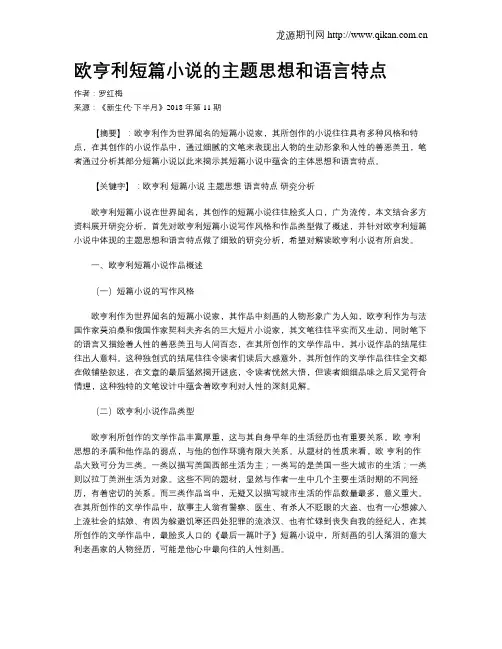
欧亨利短篇小说的主题思想和语言特点作者:罗红梅来源:《新生代·下半月》2018年第11期【摘要】:欧亨利作为世界闻名的短篇小说家,其所创作的小说往往具有多种风格和特点,在其创作的小说作品中,通过细腻的文笔来表现出人物的生动形象和人性的善恶美丑,笔者通过分析其部分短篇小说以此来揭示其短篇小说中蕴含的主体思想和语言特点。
【关键字】:欧亨利短篇小说主题思想语言特点研究分析欧亨利短篇小说在世界闻名,其创作的短篇小说往往脍炙人口,广为流传,本文结合多方资料展开研究分析,首先对欧亨利短篇小说写作风格和作品类型做了概述,并针对欧亨利短篇小说中体现的主题思想和语言特点做了细致的研究分析,希望对解读欧亨利小说有所启发。
一、欧亨利短篇小说作品概述(一)短篇小说的写作风格欧亨利作为世界闻名的短篇小说家,其作品中刻画的人物形象广为人知,欧亨利作为与法国作家莫泊桑和俄国作家契科夫齐名的三大短片小说家,其文笔往往平实而又生动,同时笔下的语言又描绘着人性的善恶美丑与人间百态,在其所创作的文学作品中,其小说作品的结尾往往出人意料。
这种独创式的结尾往往令读者们读后大感意外,其所创作的文学作品往往全文都在做铺垫叙述,在文章的最后猛然揭开谜底,令读者恍然大悟,但读者细细品味之后又觉符合情理,这种独特的文笔设计中蕴含着欧亨利对人性的深刻见解。
(二)欧亨利小说作品类型欧亨利所创作的文学作品丰富厚重,这与其自身早年的生活经历也有重要关系。
欧·亨利思想的矛盾和他作品的弱点,与他的创作环境有限大关系。
从题材的性质来看,欧·亨利的作品大致可分为三类。
一类以描写美国西部生活为主;一类写的是美国一些大城市的生活;一类则以拉丁美洲生活为对象。
这些不同的题材,显然与作者一生中几个主要生活时期的不同经历,有着密切的关系。
而三类作品当中,无疑又以描写城市生活的作品数量最多,意义重大。
在其所创作的文学作品中,故事主人翁有警察、医生、有杀人不眨眼的大盗、也有一心想嫁入上流社会的姑娘、有因为躲避饥寒还四处犯罪的流浪汉、也有忙碌到丧失自我的经纪人,在其所创作的文学作品中,最脍炙人口的《最后一篇叶子》短篇小说中,所刻画的引人落泪的意大利老画家的人物经历,可能是他心中最向往的人性刻画。
《欧亨利短篇小说集》讲解导言:在世界文学史上,美国作家欧亨利(O. Henry)是一位备受瞩目的短篇小说大师。
他的作品融合了幽默、悬疑和意外结局,深受读者喜爱。
本文将对《欧亨利短篇小说集》进行深入讲解,探索其独特之处和魅力。
第一部分:欧亨利的生平和写作风格欧亨利(1862-1910),原名威廉·波特·欧·谢特斯(William Porter O. Sheffeld),是美国最杰出的短篇小说家之一。
他在短暂的生命里创作了数百篇小说,给世界留下了宝贵的文学遗产。
欧亨利的写作风格独具匠心,叙述简洁生动,语言幽默机智,结构巧妙,以出人意料的结局见长。
他的作品常常给人带来温馨、感人和深思的体验。
第二部分:《欧亨利短篇小说集》中的经典作品1.《礼物的最高层楼》这是一篇讲述友情与奉献的温馨小说。
故事中,两位好朋友约翰和吉姆相互赠送礼物,他们都希望能给对方带来惊喜和快乐。
然而,最终他们互换的礼物却是无用的,却体现了他们深厚无私的友情。
2.《最后一片叶子》这是一篇意境唯美的小说,描绘了一个年老孤独的艺术家与一个病危女孩之间的特殊友谊。
在秋天的时节,女孩康斯兰斯突然生病住院,她最喜爱的一棵枯树的最后一片叶子在风雨中顽强地挺立。
这个小故事传达了生命的坚韧和人性的温暖。
3.《礼拜日之旅》这是一篇以幽默讽刺见长的小说。
故事主人公汤姆冯特是个贪婪的商人,为了逃避债务,他和他的妻子决定前往墨西哥。
然而,在天真无邪的三个孩子的帮助下,他们的行程充满了意外和笑料。
这个故事揭示了人性的善恶和报应的观念。
第三部分:欧亨利的作品对读者的影响欧亨利的作品深深地触动了读者的内心,给他们以启示和思考。
他通过短篇小说的形式,巧妙地展示了人性的复杂性和世间的种种困境和机遇。
他的作品积极传递了人与人之间关爱和友情的力量,引发了读者对情感生活和人性的思考和回味。
结论:通过对《欧亨利短篇小说集》的讲解,我们深入了解了这位美国文学大师的生平和写作风格。
20XX-欧亨利开题报告-优秀word范文(4页)以下是为大家整理的2019-欧亨利开题报告-优秀word范文(4页)的相关范文,本文关键词为2019-,亨利,开题,报告,优秀,word,范文,4页,2,您可以从右上方搜索框检索更多相关文章,如果您觉得有用,请继续关注我们并推荐给您的好友,您可以在论文资料中查看更多范文。
2019-欧亨利开题报告-优秀word范文本文部分内容来自网络,本司不为其真实性负责,如有异议或侵权请及时联系,本司将予以删除!==本文为word格式,下载后可随意编辑修改!==欧亨利开题报告欧亨利又译奥亨利,原名威廉西德尼波特,美国短篇小说家,美国现代短篇小说创始人,曾被评论界誉为曼哈顿桂冠散文作家和美国现代短篇小说之父,他的作品有美国生活的百科全书之誉。
用合作原则和关联理论分析欧亨利短篇小说对话的会话含义开题报告??xxxx大学本科生毕业论文(设计)开题报告书xxxx大学本科毕业论文(设计)任务书编号:论文(设计)题目:用合作原则和关联理论分析欧亨利短篇小说对话的会话义学院:xxx学院专业:英语教育班级:xxxx级英语教育x 班学生姓名:xxx学号:xxxxxxxxx指导教师:xx职称:副教授1、论文(设计)研究目标及主要任务本论文的研究目标是探讨合作原则和关联理论在文学作品中的应用。
其主要任务通过分析两个原则在文学中的应用而指导分析文学作品。
2、论文(设计)的主要内容本论文分为五章,第一章整体介绍论文的结构和研究的意义,第二章对相关文学作品和语用学理论的文献论述。
,第三章介绍合作原则和关联理论,第四章运用两个原则对欧亨利小说中对话进行分析,第五章论文总结。
3、论文(设计)的基础条件及研究路线本论文的基础条件是不同的语言学家对相关理论的运用研究。
研究路线是运用合作原则和关联理论对欧亨利短篇小说对话进行分析。
其主要任务是通过分析两个原则在文学中的应用指导分析文学作品。
4、主要参考文献最后,小编希望文章对您有所帮助,如果有不周到的地方请多谅解,更多相关的文章正在创作中,希望您定期关注。
欧·亨利的短篇小说构思巧妙,素以出人意料的结尾著名。
顺着小说中故事情节的发展线索,小说最后情节往往出现令人意想不到的结尾,与最初揆度相去甚远。
但再细细想来,这样的结尾却又合乎情理而非荒无诞稽,收到“含不尽之意,见于言外”的妙效,让人不得不折服于他的独具匠心。
一、伏笔的艺术欧·亨利在处理结尾时的独到之处,犹如在读者面前进行一场魔术表演。
他的短篇小说之所以是完美的艺术品,巧妙的情节安排和结尾起了相当大的作用,而正是前文的伏笔使结尾“意料之外”回归“情理之中”来。
《警察与赞美诗》中,苏比一连串批斗性的举动埋下伏笔,以警察的听之任之的态度造成一种错觉——苏比这个冬天肯定与监狱无缘了。
然而就在结尾的两行字里,苏比却遭到了命运的嘲弄,被警察随便找了个理由丢进了监狱。
这里苏比的被捕在读者意料之外,然而被捕的理由却在情理之中,因为类似的方法苏比之前一直在实行,只是没有成功罢了。
《最后一片藤叶》则采用了侧面刻画人物的别致手法,让一个啰嗦、火气十足的“失败画家”画出那幅不朽的杰作——最后一片藤叶,从而挽救了青年艺术家琼西,同时也揭示了老艺术家贝尔门的美丽心灵。
贝尔门的去世在读者意料之外,然而他在寒风中为青年艺术家琼西创作最后一片藤叶的事实却给了他染风寒去世的合理性。
这两个故事异曲同工,分别而又统一地显示出了欧·亨利式的结尾的艺术造诣。
二、修辞的艺术排山倒海式的排比与异想天开的夸张是成就欧·亨利式的结尾的两大功臣。
如《酒吧里的世界公民》,作者排山倒海式的排比借助考格兰之口将包袱抖的十足,好似泰山压顶,咄咄逼人,连读者都为这名伟大的国际主义者所叹服。
然而就在小说的结尾,这位考格兰先生却对别人大打出手,只因为那人说他的家乡缅因州的路和水太差,而他则一点也容不得别人说他家乡的坏话。
至此这位国际主义者叶公好龙的真面目大白于天下,而又一个经典的欧·亨利式的结尾已然诞生。
不难发现,没有之前那段排山倒海式的排比,那么故事的结尾就将黯然失色。
摘要: 作为世界三大小说家之一,欧亨利与契诃夫和莫泊桑齐名。
他的作品因奇巧的艺术构思,出其不意的结尾而著称。
本文以欧亨利的三篇著名短篇小说为例,主要分析了“意料之外情理之内”的“欧亨利式结尾”的处理方法,包括营造出人意料但又符合情理的结尾效果的不同方法,以及这样的结尾方式如何能更深刻的表达人物的情感与小说的主旨。
关键词:艺术手法,人性,社会现实,欧亨利式结尾Unexpected and reasonale ending——A Brief Comment on O’ Henry’s Short Stories Abstract: O. Henry, one of the three most famous short-story writers in the world, enjoys equal status with Chekhov and Maupassant. Exquisite plot, wry humor and twist ending dominate his works. Those surprising but logical endings are the most brilliant in all of the highlights. This thesis mainly analyses O. Henry’s surprising but logical endings of his famous works such as The Gift of the Magi , The Last Leaf an and The Cop and the Anthem.These O. Henry-style endings impress readers ,and at the same time ,help him express his ideas completely and vividly.So this thesis mainly analyses how O’ Henry set the plot to achieve the desired ending effect,and how the twist ending help idea-expression.Key Words:artistic styles; humanity; social reality; O. Henry-style endingContents1. Introduction (1)2. Unique O-style endingmethod (2)2.1 Improbable coincidence (3)2.2 Sharp contrast………………………………………………………………………42.3 Repetition and change (6)3. Conclusion (8)Bibliography (9)1. IntroductionO. Henry, originally named William Sydney Porter, is a distinguished American storywriter. He wrote more than 300 short stories in his life. His stories are full of colorful characters. He creates an original, typically American democratic form of short stories with, at its best, a valuable critical awareness of life and society tellingly expressed through humor. Therefore, some critics call him “the founder of American stories”. Being gifted with humor and a keen awareness of details, he objectively shows us what America looks like. All his stories putting together constitute a true panorama of American life.This thesis mainly emphasizes O. Henry’s unique twist ending.The ending of an article has long been considered as a conclusion or just a summary of the whole passage. However, O. Henry illustrates a new way, the so-called twist ending or sometimes the O. Henry’s ending. It means that at the end of an article the mental status or the fate of the character has changed greatly. But the whole passage is suddenly endowed with a great charm because of the ending. The author has your nerves all a quiver until the lastsentence. The surprise comes quickly and the story is finished. O. Henry is such a master of the unexpected ending that one must admire his skills. 2. Unique O-style ending methodO. Henry's trademark is the surprising ending that each of his stories contains. He sets a story moving in one direction, and just when the reader is convinced of the general direction of the narrative, the story will be completely reversed.This kind of ynexpected but reasonable ending which called O.Hernry’s ending may be a little sorrowful but it still gives the readers some hope,which is so-called “O.Henry’s humor(smile with tears)”. And if we look back to the total story, the ending seems logical and plausible. As a “plot-maker”, and designer of incident, he is an amazing genius. No one can do better than him to holds the reader in “suspense”. More than that, the reader scarcely knows that he is suspended until the very close of the story. Just as turns on the lights and the whole tale is revealed in its entirety. He uses this device of dramatic and humorous effect in the short story collection The Four Million which including “The Gift of the Magi ”, and “The Cop and the Anthem”, “the Service of Love”, “The last Leaf.”He often stresses on something important but not the most important in his works.The most important part always seems to write incidentally,which eben the most circunspective reader may ifnore it.When the stories end in a totally unexpected but reasonable way ,we can do nothing but cheer for O.Henry’s literary talent.2.1 Improbable coincidence (The Gift of the Magi)The novel “The Gift of the Magi” is about a young couple that is short of money but desperately wants to buy each other Christmas gifts. Unknown to Jim, Della sells her most valuable possession, her beautiful hair, in order to buy platinum as the chain for Jim's watch; unknown to Della, Jim sells his most valuable possession, his watch, to buy jeweled combs for Della's hair.In the end ,both gifts became useless——short-haired Della got a comb and Jim got a chain for an already-sold watch.What a surprising coincidence! However, when we look back, we can find that O.Henry had already given us some suggestions.”Now, there were two possessions of the James Dillingham Youngs in which they both took a mighty pride. One was Jim’s gold watch that had been his father’s and hisgrandfather’s. The other was Della’s hair.” This description is related to how they got the money for gifts and what they bought for each other. The auther used a casual and vague tone deliberately so that few people would think over its meaning before seeing the ending. So the ending turns out to be unexpected but reasonable.This coincidence is filled with complex emotions. People feel touched by the longlasting true love between the young couple and at the sametime ,pity for them for their “unwise” gifts and their cruel bitter life.Though confronted with cruel reality and dull daily routine, Della and Jim can never change their eagerness toward love. To them the most valuable material possession is so slight and insignificant ,when compared with the spiritual possession of love romance.Perhaps the gifts were "unwise" as the author says, but, as he further writes, "let it be said that of all who give gifts, these two were the wisest.”In The Gift of the Magi , we feel so pity that Della has her precious long hair cut. But to our surprise ,Jim has sold the watch to buy the jeweled tortoise-shell combs for her wife’s hair. O.Henry does not end on the note of irony and surprise but gives to what he calls his uneventful coincidenceof two foolish children the appearance of a little parable with a significant meaning. The magi , he reminds the reader ,were wise men who brought gifts to the Christ child. As for Jim and Della, the are the magi. This is the ending of the story with O.Henry’s own style.2. 2 Sharp contrast (The last leaf)In this story, Johnsy and Sue are artists who move into Greenwich Village in New York City. As Winter approaches and the weather gets colder, Johnsy becomes ill with pneumonia. She gets so sick that she believes that when the last leaf falls from the vine outside her window, she will die. An old artist, named Behrman, who lives in the same building as the girls, braves a storm one night to paint a leaf on the wall — a leaf that will never fall. Cold and wet from painting in the icy rain, he catches pneumonia and dies. This gives Sue the hope to survive her illness, and it also creates the masterpiece Behrman had always dreamed of painting.After reading the novel,we can find that Behrman rarely appears and O.Henry spent few words on him .We only know that he is a bad-tempered old painter. “He was past sixty and had a Michael Angelo's Moses beard curling down from the head of a satyr along with the body of an imp.”“Behrman was a failure in art”. Behrman earned little money by serving as a non-professional model and was a terrible alcoholic who sometimes “talked of his coming masterpiece”. He was “a fierce little old man, who scoffed terribly at softness in any one”.To be honest, Behrman was not a traditonal pleasing hero at all. He was fierce in personality , poor in money and untalented in painting.However, it is exactly him who saved Johnsy in a silent and artistic way——painting a leaf on a wall. This leaf gives Sue the hope of living, making her realize that: “It is a sin to want to die”.O.Henry did not tell how he helped Sue, how he painted his masterpiece and why he chose to do it deliberately but readers knew it from the conversation between Sue and Johnsy indirectly . Many details point to a truth that the old artist sacruificed his life to restore Sue’s will to live. All these things took place in a cold storming night and Behrman told no one about his plan. It shows that he did it not for praise, but just for saving a young girl.Behrman, given few show-ups and descriptions by the author , was rarely concerned by readers in early plot.Many people even think he is just an unimportant supporting role.But when we see the ending and know the truth, we find we were completely wrong. Behrman was a hero and a savior who did not only save a person’s life, but successfully saved an American dream for all the people who seek freedom and peace, connecting the social reality of that time.“The last leaf” is the symbol of hope, life and faith. Behrman seemed more alive than dead.This Sharp contrast strenthens the theme of love and sacrifice. Behrman’s behavior seemed more praiseworthy and inspiring after readers’psychological change . That’s what O.Henry wants to achieve. Though the touching ending makes us absorbed in sadness, the readers can still find gleams of hope and desire out of despair.2.3 Repetition and change (The Cop and the Anthem)In the story The Cop and the Anthem, Soapy, a homeless tramp, deciding to be sent to the prison on the Island which he called his winter quarter against the rigor and the hunger, attempted to practice several illegal activities for the purpose of “wooing capture”; but the cop, who stood nearby when Soapy was trying to attract his attention by his anti-law behavior, paid no special attention to Soapy every time, even “seemed toregard him as a king who could do no wrong”.Developing up here, the story must give the reader the conclusion that Soapy had to go back disappointedly to his home—a park bench. On his way, the sweet music of anthem from the church played by the organist and the beautiful moonlight scenery “wrought a sudden and wonderful change in his soul”, he made up his mind to “pull himself out of the mire”and “make a man of himself again”.Moving like this, the plot is not completely understandable at once. When the reader is puzzled about the use and meaning of growing plot, and just while Soapy was planning his tomorrow’s action for being “somebody in the world”, an unforeseen plot, and just while abruptly: he was arrested because a policeman thought him doubtful, and the next day he was sentence to “three months on the Island”.The story stops here suddenly in spite of the reader’s not immediate understanding. But after a moment of consideration, the reader’s surprise turns into admiration for his astonishing contrivance of tricky ending which reveals rigorously the real facts of reversal between truth and falsehood in capitalist society which confuses right and wrong.In this short stories, the plot develops as Soapy’s various anti-law behaviors being ignored by the cop time and time again. This kind of repetition may disappoint and bore readers in some degree.However, it’s exactly the highlights of the story. The more such repetition occurs the more confused and curious readers become. They can’t help wondering, “Why did all these happen again and again? What followed next? How will Soapy finally become?”and so on. Then there comes the change,which is also the climax——Soapy was inspired by the anthem from the church, but before he can truly make a brand new start in his life ,he got arrestted just because he looked like a criminal. With those repetitions in early times, the final ending seems so ironic and unexpected. Soapy seems more suffered being born in that rough-and-tumble age.3. ConclusionTotally speaking, in O. Henry’s works, the events of some short stories are arranged in the spe cific order which exceed reader’s normal expectation to the arrangement of those events in his works, make the ending unpredictable and strange. O. Henry deliberately designs the little tricks with words, for he is a master of language and not its slave.These unexpected but reasonable endings, in many conditions ,are the most remarkable parts in the novel. They also engage something profound in the human psyche and reflect sociel reality in that age . Bibliography[1] Medrick, Fred. An introduction to American literature[M]. Henan University Press, 1985[2] Hudson, Long. O Henry The Man and His Work[C]. New York:Russell and Russell, 1969[3] O, Henry, Heart of the West[M]. New York: McClure, 1907[4] O, Henry, The Four Million[M]. New York: Dobleday, Doran and Company. 1906[5] O, Henry, 欧亨利短篇小说[6] 李国宁. 欧亨利式结尾的艺术魅力[7] 赵书颖. “含泪的笑”与“含笑的泪”浅析欧•亨利的主题[8] 赵丽,黄春妮. 欧亨利作品导读[M]. 武汉: 武汉大学出版社2003 P3[9] 欧亨利. 四百万[M]. 北京:外语教学与研究出版社,1988。
欧亨利读后感欧亨利(O. Henry)是美国著名的短篇小说家,他的作品以其幽默、机智和意外的结局而闻名。
读完欧亨利的作品,我深受启发,深刻感受到了他对人性的洞察和对生活的独特见解。
在他的作品中,我看到了对人性的揭示和对人生的思考,这让我对生活有了更深刻的认识。
欧亨利的作品中,最让我印象深刻的是他对人性的揭示。
他通过他的作品展现了人性的复杂和多样性。
在他的作品中,有善良的人,也有自私的人;有勇敢的人,也有懦弱的人。
他通过这些不同的人物刻画,向我们展现了人性的复杂和多样性。
在现实生活中,我们也可以看到这样的人性。
有时候,我们会发现一个人在某个时刻表现出善良和慷慨,而在另一个时刻却变得自私和冷漠。
欧亨利的作品让我明白,人性是复杂的,我们不能简单地用好坏来划分一个人,而是要了解他的内心和背后的故事。
另外,欧亨利的作品也让我对人生有了更深刻的思考。
他的作品中,常常出现令人意想不到的结局,这让我深受启发。
在现实生活中,我们也经常会遇到意想不到的事情,生活就是充满了未知和变数。
欧亨利的作品让我意识到,人生就像一部未知的小说,我们永远无法预料下一步会发生什么。
因此,我们需要学会接受生活的不确定性,勇敢面对生活中的挑战和困难。
同时,我们也应该学会珍惜眼前的幸福,因为生活中的美好可能随时会消失。
总的来说,欧亨利的作品给我留下了深刻的印象。
通过他的作品,我深刻感受到了他对人性的洞察和对生活的独特见解。
他的作品让我对人性有了更深刻的认识,也让我对人生有了更深刻的思考。
我相信,欧亨利的作品会一直陪伴着我,让我在生活中更加深刻地理解人性和人生。
欧亨利短篇小说调查研究报告篇一:英语论文-欧亨利短篇小说中的人物形象分析
英语论文-欧亨利短篇小说中的人物形象分析
附表6:
本科毕业设计(论文)开题报告
课题名称:
欧亨利短篇小说中的人物形象分析
系别:
专业:
英语教育
指导教师:
作者姓名:
一、综述本课题国内外研究动态,说明选题的依据和意义
欧·亨利(o·hey,1862-1910).美国著名短篇小说家。
欧亨利善于观察生活各个方面,其故事人物一般都是他寄予同情的小市民,情节颇多偶然巧合,结局往往出人意料。
国内外对欧·亨利的短篇小说的研究已经深入到了他的作品的各个方面,如欧·亨利小说的结构艺术。
象他的独特的小说结尾;他的小说的写作技巧与风格,象充斥于作品的字里行间的幽默与讽刺。
以及作品的主题社会意义等各个方面。
评论家弗门(h·j·forman)认为亨利“具备漠泊桑的技巧,
而幽默上则远超过他。
”
描写社会底层的小人物是十九世纪末和二十世纪初现实主义文学的一大特色,但从世界范围来进行衡量,象欧亨利在《四百万》中那样以明快,抒情的描写手法写出这些小人物的命运,写出他们的内心痛苦和快乐的小说实不多见。
更主要的是通过一些小人物命运的描写,在戏而不谑的讽刺和怒而不哀的揭露中,显示出作者对社会的抨击。
本选题将在国内外学者研究的基础上,着重探讨作者在短篇小说中所创造的人物形象。
在作者数量众多的短篇小说中,我们可以见到当时美国社会形形色色的人物:小人物、骗子、富翁等。
这些形象已有不少成为世界公认的艺术典型。
欧·亨利短篇小说中塑造的人物形象为人们认识十九世纪末至二十世纪初期的美国社会提供了生动而准确的形象材料。
二、研究的基本内容,拟解决的主要问题:
欧·亨利是美国文学史上优秀的短篇小说家。
本课题研究的是欧·亨利短篇小说中塑造的人物形象。
作者写了许多故事,围绕虚假的掩饰,无情的欺骗,伪装的高贵等主题,塑造了众多栩栩如生的人物—贫穷但快乐的小人物,善良的骗子,阴险狡诈的富翁等等。
他运用写实手法,具体刻画情节,同时穿插幽默与讽刺于情节中,成功的塑造了许多典型的人物形象。
作者独特的小说结构艺术,写作技巧与风格是小说人物形象塑造成功的重要因素,是值得我们模仿和借鉴
的。
很有研究价值。
三、研究步骤、方法及措施:
本研究涉及到四大步骤:选题、查找资料、定题和写提纲,以及最后完成论文的主体部分。
选题是基于阅读多篇资料后所得到的感想,收集的资料来源于学校图书馆,系资料室,电子阅览室以及互联网。
定题和写提纲是在详细阅读查找的资料后,对自己所获得信息的选择和综合。
本课题将从作品对人物形象的分类以及其写作手法,如写实手法,情节刻画和幽默与讽刺手法及作品体现的主题思想三个方面来研究怎样成功的塑造人物形象,以及形形色色的人物形象对深化作品主题和体现作品中蕴含的社会意义等方面所起的作用。
四、研究工作进度:
五、主要参考文献:
篇二:欧亨利短篇小说中冷暖论文
欧亨利短篇小说中的冷与暖
摘要:欧亨利小说是美国短篇小说的经典之作,他的小说有独特的艺术技巧。
此篇论文主要从小说包含的思想内容、情感基调出发,从心理学角度探讨欧亨利小说给人的冷与暖的感觉,并对此作一些分析。
关键词:心理学欧亨利感觉冷暖
中图分类号:g206 文献标识码:a文章编号:
1673-9795(XX)01(b)-0000-00
1欧亨利小说鲜明冷暖基调的原因:个人和社会
欧亨利是生活在美国社会的苦命且悲剧性的人物,他的一生充满艰辛与妥协。
他在幼年饱尝母亲早逝,父亲堕落,婶婶嫌弃的辛酸,性格比较孤僻;人到中年,他未享受婚姻的快乐就因为莫须有的“盗用公款”罪名过早地开始了颠沛流离的逃亡生涯;他没赶上看爱妻的最后一面,就被抓进了牢狱,在牢狱里体验到了最恶劣的生活状态并为他小女儿的抚养费而尝试写作;提前出狱后,他隐姓埋名继续写作,那个时期堪称他写作的丰产期,优秀作品如泉涌出;他的第二次婚姻很不幸。
因此他在四十八岁病逝于纽约,结束了他富有传奇色彩和悲壮旋律的一生。
正因为欧亨利的生活经历是如此丰富曲折,所以他对人事、社会、情感的思考就比别人更深一层,更广阔些。
他对求生的理解,远远高于养尊处优无所事事的贵族;对家庭的理解,远远高于沉浸在柔情蜜意里的青年;对社会阴暗面的透视,远远高于煞有介事的政府官员。
篇三:欧亨利短篇小说的艺术特色分析
欧亨利短篇小说的艺术特色分析
论文。